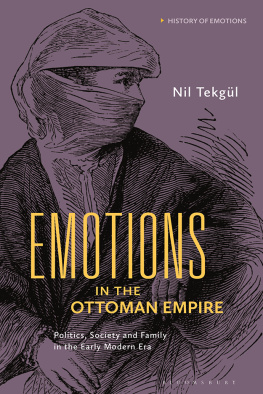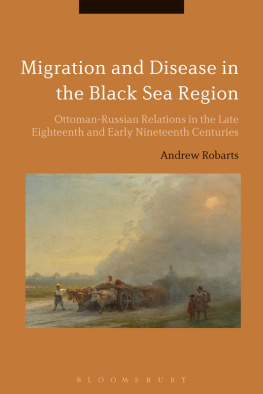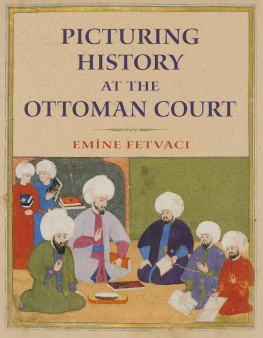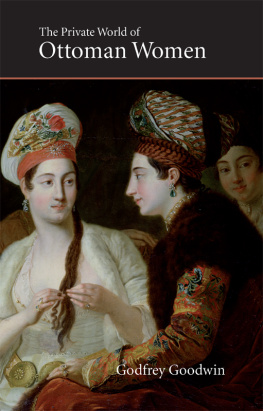OTTOMAN TULIPS, OTTOMAN COFFEE
To my parents, Amal and Wael, whose names mean exactly what they have given me: Hope and Refuge

Published in 2007 by Tauris Academic Studies, an imprint of I.B.Tauris & Co Ltd
6 Salem Road, London W2 4BU
175 Fifth Avenue, New York NY 10010
www.ibtauris.com
In the United States of America and Canada distributed by Palgrave Macmillan a division of St Martins Press, 175 Fifth Avenue, New York NY 10010
Copyright 2007, Dana Sajdi
The right of Dana Sajdi to be identified as editor of this work has been asserted by the editor in accordance with the Copyright, Design and Patents Act 1988.
All rights reserved. Except for brief quotations in a review, this book, or any part thereof, may not be reproduced, stored in or introduced into a retrieval system, or transmitted, in any form or by any means, electronic, mechanical, photocopying, recording or otherwise, without the prior written permission of the publisher.
ISBN 978 1 84511 570 8
eISBN 978 0 85773 180 7
A full CIP record for this book is available from the British Library
A full CIP record is available from the Library of Congress
Library of Congress Catalog card: available
List of Tables and Figures
Tables
Figures
Notes on Contributors
CAN ERIMTAN is an independent scholar. He received a D.Phil. in 2003 in modern history from Oxford University, where he wrote a thesis on the historiography of the tulip age. In 20045, he was research fellow at the British Institute of Archeology at Ankara, where he worked on the perception of the Hittites in early republican Turkey. He was senior fellow at the Institute of Anatolian Civilizations, Istanbul.
ALI AKSU is assistant professor and chair of the Department of Philosophy, Fatih University, Istanbul. From 2000 to 2006, he was a research fellow at the Research Centre for Islamic History, Art and Culture (IRCICA), a subsidiary organ of the Organization of the Islamic Conference (OIC). He earned his BA in 1991 from the Department of Political Science and International Relations at Boazii University in Istanbul. He received his MA in Islamic thought in 1993, and a Ph.D. in philosophy in 1999, from the International Institute of Islamic Thought and Civilization (ISTAC), Kuala Lumpur, Malaysia.
ALAN MIKHAIL is a Ph.D. candidate in the Department of History at the University of California, Berkeley. His interests include the history of science, agricultural history and the cultural history of Ottoman cities. He has published numerous articles in Arabic on various topics in Egyptian history, and is currently writing a dissertation on the cultural history of water, irrigation and health in Ottoman Egypt.
BABAK RAHIMI is assistant professor of Islamic Studies at the Department of Literature, Program for the Study of Religion, University of California, San Diego. Rahimi received his BA from the University of California, San Diego, his MA from the University of Nottingham, and his Ph.D. in 2004 from the European University Institutes Department of Social and Political Science. He was a visiting fellow in the Department of Anthropology at the London School of Economics and Political Science, 20002001. He has published articles in Iranian studies and critical theory and historical sociology; his main research interest evolves around statesociety relations in Islamic societies.
ORLIN SABEV (ORHAN SALIH) is a research fellow at the Institute of Balkan Studies, Bulgarian Academy of Sciences, Sofia. He received his Ph.D. from the same institution in 2000. His dissertation on Ottoman educational institutions in Bulgarian lands between the fifteenth and eighteenth centuries was published in Bulgarian under the title Ottoman Schools in Bulgarian Lands 15th18th Centuries (Sofia: Ljubomadrie-Chronia, 2001). His second book, also in Bulgarian, The First Ottoman Journey in the World of Printed Books (17261746): a Reassessment (Sofia: Avangard Prima, 2004) is now forthcoming in Turkish. He received the Professor Marin Drinov Prize for Young Scholars of the Bulgarian Academy of Sciences in 2002.
DANA SAJDI is a post-doctoral fellow at the Wissenschaftskolleg zu Berlin. She received her Ph.D. from Columbia University in 2002. She was assistant professor of Middle East history at Concordia University, Montreal, 20024; and a Mellon fellow at Princeton University 20045. She is currently working on a monograph entitled The barber of Damascus: nouveau literacy in the early modern Middle East. On the subject of her book, she has published an award winning article A room of his own: the history of the barber of Damascus (fl. 1762) (The MIT Electronic Journal of Middle East Studies, 4 (2004), pp. 1935).
Preface, Note on Transliteration and Acknowledgements
The present volume is a result of a conference, Rethinking culture in the Ottoman eighteenth century, which took place in Princeton on 1516 January 2005. Although a very large number of excellent proposals were submitted in response to the call for papers, all things being equal, priority of participation was given to junior/graduate students and international scholars. After the conclusion of the conference, a committee of five senior and junior scholars was formed for the purpose of selecting the conference papers to be published. Once chosen, the papers were sent out for anonymous peer review and subsequently revised by the authors. Thus, this volume is the end result of a long process that could not have been completed without the work and dedication of a number of colleagues.
Given the multilinguistic legacy of the Ottoman Empire, however, no attempt has been made to privilege any one of the relevant Middle Eastern languages in terms of transliteration, especially with regard to shared terms between Arabic, Persian and Ottoman. Similarly, the choice of rendering titles and names into English or Turkish has been left to the individual authors.
I offer my first consignment of gratitude to Michael Cook, who invited me to organize a conference on the eighteenth century. To that end, he entrusted me with some of his Mellon Foundation grant funds with no strings attached. He interfered in neither conceptualization nor logistics; however, he always came through whenever his support was needed. In short, he proved to be the ideal patron.
At Princeton, ukru Haniolu generously offered funds from the M. Munir Ertegn Foundation to cover some outstanding expenses. Kathy ONeil gave her indispensible administrative help and Kim Hegelbach enthusiastically shared her knowledge of the nooks and crannies of the university campus and bureaucracy. Relief from constant organizing and busy deliberation was provided by the tradition of Tuesday dinners with the happy company of Shahab Ahmed, Yossi Rappoport and Gilat Levy.
Through the duration of the conference and beyond, I benefited from the advice and support of various scholars. I thank Norman Itzkowitz and Rifaat Abou-El-Haj for sharing their wisdom, and Elizabeth Frierson for a stellar performance at the conference and after. Immense gratitude is due to Madeline Zilfi for so kindly investing in this project time and work well beyond the call of duty. For their work behind the scenes, I am grateful to Heghnar Watenpaugh, Baki Tezcan, Selim Kuru and Shahab Ahmed.
I also thank the individual contributors to this volume for being patient with a particularly demanding editor, and for taking the risk of participating in a project composed entirely of young scholars.







